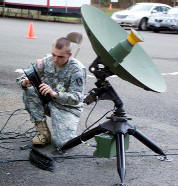- Homepage >
- Organization >
- Mission Command
Mission Command
U.S. Army
Operational Test Command Mission Mission Command Test Directorate plans, conducts, and reports on independent operational tests, assessments, experiments and rapid initiatives of Enterprise and Tactical Mission Command systems in order to provide essential information for the decision-making process for acquisition and fielding. Who
We Are
91014 Station Avenue, ATTN: TEOT-MC
Fort
Hood, Texas 76544-5068
Mission Command and Communications Test Division.
Enterprise and Information Systems Test Division.
What We Do
Test systems that will process and transmit voice, data, messaging, and video information through networks at the tactical, operational, strategic, and sustaining-base levels.
Assure that information storage and transmission are security, available, and protected from hostile or accidental destruction or release.
Serve as the lead directorate for the Army in testing NETCENTRIC Battle Command and Communications systems, e.g., WIN-T, JTRS, NECC, and CS 11-12.
Conduct Forward Operational Assessments (FOAs) of Battle Command Systems.
History
The earliest reference to this subject that we can find concerns a "Theater Board" that met in France in April 1919 to consider lessons learned during World War I. Shortly afterwards, the Army developed the concept of "Service Testing," that is, as much as possible, military equipment would be tested under realistic conditions. This marked an important step forward in the establishment of permanent agencies to study the ever-changing needs and problems of the Army.
Shortly after WWI, the Signal Board at Fort Monmouth, New Jersey, was listed as one of nine boards in existence. Due to fiscal limitations, however, there was very little equipment test and evaluation, but the Army was beginning to get the right idea. That is, and it seems very evident to us now, that small quantities of prototype equipment should be bought and these items tested under conditions representing actual use. During World War II, the Signal Board served as a "Technical Service" providing coordination, liaison, and observers, what we now call subject matter experts, to speed up the testing and redesign process.
A reorganization of all nine Army boards in September 1945, consolidated them into just three. The Communications and Electronics Service Test Section was assigned to Army Ground Forces Board #1 at Fort Bragg, North Carolina. Board #1 was the "high tech" board. In January 1957, the boards were transferred to the new Continental Army Command (CONARC). The board with C-E responsibility was then called the Airborne and Electronics Board, and remained at Fort Bragg.
In 1978, the C-E responsibility of the board at Fort Bragg was split and a new C-E board formed at the home of the Signal Corps, Fort Gordon, Georgia. Ten years later (in 1988), the C-E Board at Fort Gordon became a part of Training and Doctrine Command's (TRADOC's) Test and Experimentation Command (TEXCOM). In November 1990, the Secretary of the Army established the U.S. Army Operational Test and Evaluation Command (OPTEC), and TEXCOM became a part of OPTEC. Every TEXCOM Board at the time became a TEXCOM test directorate. Four of the new directorates that were not physically located at Fort Hood, Texas, were closed and moved there. In March 1991, the C-E Test Directorate at Fort Gordon was closed, and the Command, Control, and Communications Test Directorate (C3TD) was formed at Fort Hood.
Initially, C3TD was located in Building 91010 at West Fort Hood, Texas. It later gained another division, this was the former Office of Test and Evaluation (OTEA) Field Office at Fort Hood, and moved to Radar Hill at West Fort Hood. C3TD had been using Radar Hill for years as a good, out-of-the-way place to conduct radio tests. After some improvements to the infrastructure, TEXCOM purchased several portable buildings, set them up on Radar Hill, and moved the entire directorate there in 1991.
TEXCOM's second major, new office building, located adjacent to TEXCOM's Headquarters building, was dedicated in November 1995. The decision was made to move C3TD, and two other directorates into it immediately after it was finished. In August 1995, C3TD headquarters, the two divisions, and the individual tests vacated Radar Hill and took up permanent residence in the new building.
On October 1, 1999, C3TD gained the Fort Gordon Test & Evaluation Coordination Office (TECO) and another division, the Information Mission Area Test Division, formerly one of the eleven operational test activities under OPTEC. Unfortunately, on October 31, 2002, the TECO was deactivated.
For a couple of years we were the Battle Command and Communications Test Directorate (BCCTD). We are now the Mission Command Test Directorate (MCTD) under the U.S. Army Operational Test Command.
